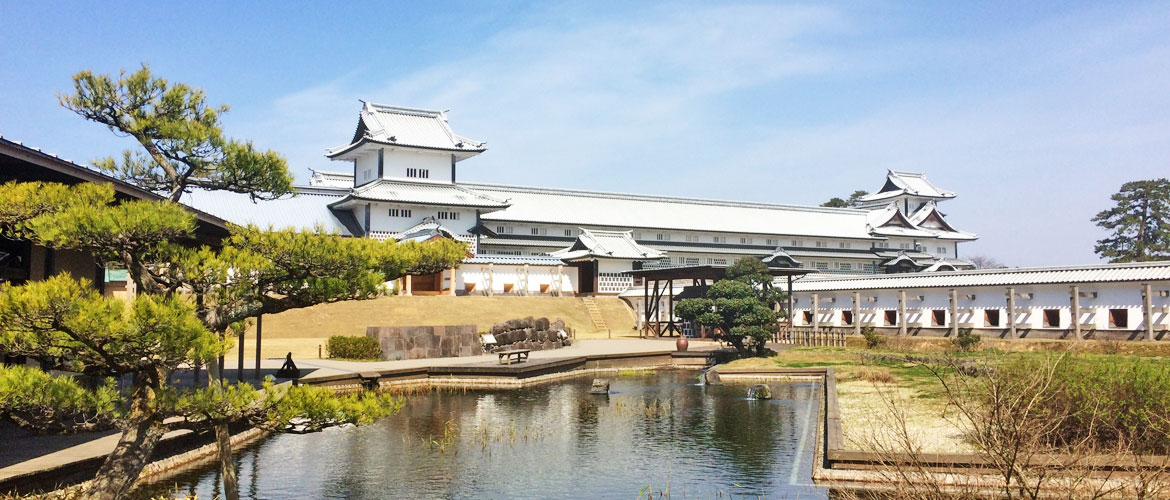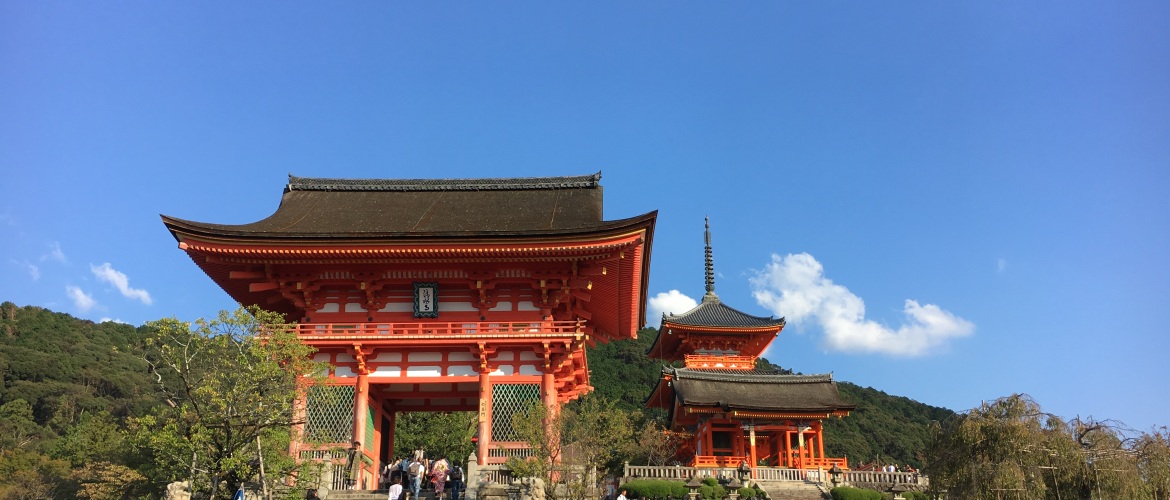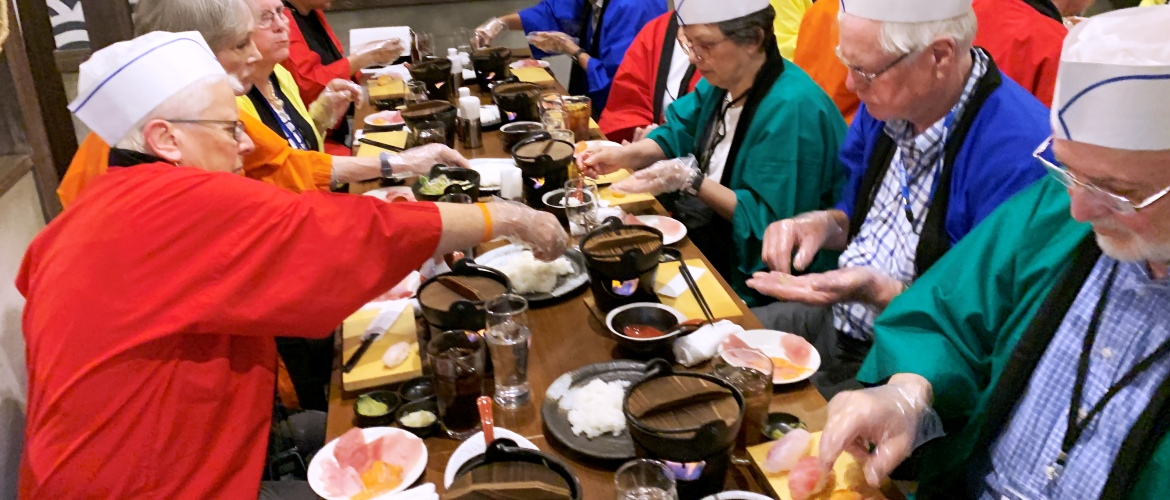
Tokyo – Mt. Fuji – Hakone – Kanazawa – Kyoto – Nara – Osaka – Hiroshima – Nagasaki – Okayama – Kochi – Tokyo
Highlights of this extraordinary itinerary include a multitude of cultural and natural landmarks, immersive activities and gourmet cuisine. Onsen (hot spring) bathing and visit to a Japanese snow monkey park are added bonuses.
Important Features
- Expert guides
- Small group size – average 15, maximum 25
- First class accommodations
- High-quality Japanese & international cuisine
- Inter-city travel by bullet train wherever available
- Private dinner show featuring a geisha apprentice
- Sushi making lesson
- Inclusion of gratuities to local guides and drivers
- Daily breakfast plus some Western lunches and traditional Japanese dinners
Meal Code: B = breakfast / L = lunch / D = dinner

Day 1/Mon: Departing Home City
The journey begins with your transpacific flight departing from a city of your choice. You’ll lose a day upon crossing the International Date Line.
Day 2/Tue: Arrival in Tokyo
Welcome to Tokyo!
Meet our driver on arrival and transfer to the hotel in a private vehicle. No activity is scheduled for today.
Be sure to withdraw some local cash from an ATM before hitting the road as you might need cash for small purchases such as snacks after hotel check-in. Guests arriving ahead of tour schedule are advised to get to the hotel by the Airport Limousine Bus which costs 3,200 yen from Narita airport and 1,150 yen from Haneda airport. Taxi is too expensive and train can be confusing and inconvenient. You can pay for your shuttle bus fare with a credit card.
Day 3/Wed: Tokyo (B/L)
Meeting time in the lobby next morning will be conveyed to you the night before.
Tokyo, literally meaning “eastern capital” and officially named Tokyo Metropolis, is one of the most populous mega-cities in the world with a population of 14 million (April 2022) in the city proper. The city covers an area of 2,187 square kilometres following the merger in 1943 of the city of Tokyo and Tokyo Prefecture.
Formerly known as Edo, the city has been the de facto seat of the Japanese government since 1603 when shogun Tokugawa Ieyasu chose the city for his headquarters. The shogun (general) was a hereditary commander ceremoniously appointed by the emperor but held real power over the country during the shogunate period between 1192 and 1867. Edo was renamed Tokyo after Emperor Meiji moved here from Kyoto in 1868 when the last shogun was forced to return power to the imperial court, a historical event known as Restoration of Imperial Rule which marks the beginning of the Meiji Restoration (1868-1889).
Our full-day sightseeing begins with a stroll across the plaza in front of the Imperial Palace (the palace itself is closed to tourists). This is followed by a visit to the tranquil Meiji Jingu, a Shinto shrine dedicated to Emperor Meiji (1852 -1912) and his wife.
We then drive through the ritzy Ginza shopping district to Nakamise-Dori in Asakusa district. Nakamise-Dori is a vibrant promenade lined with food stands and souvenir shops. The street connects the famous Asakusa sightseeing spots of Kaminarimon (Thunder Gate) and Asakusa Kannon Temple (also known as Senso-ji Temple), the oldest temple in Tokyo that dates back to 628.
We spend the rest of the day exploring the history of Tokyo at the Edo-Tokyo Museum. The highlights of the permanent exhibitions here include the life-sized replicas of the Nihonbashi (Japan Bridge), the Nakamuraza Theatre and the scaled models of towns and buildings from the Edo, Meiji and Showa (1926 -1989) periods.
We end the day with a visit to Tokyo Tower for a bird’s eye view of the city.
Day 4/Thu: Tokyo – Mt. Fuji – Hakone (B/L/D)
We explore Ueno Park and the nearby Tokyo National Museum in the morning. Afterwards we head to a restaurant for a sushi making lesson.
The afternoon drive to Mt. Fuji takes three hours.
At 3776 metres above sea level, Mt. Fuji is the highest mountain in Japan and is frequently used as a symbol of the country. We stop by the Fujisan World Heritage Center to view the summit and learn about the history, formation and ecology of Mt. Fuji through exhibits and a short film. Because the summit of Mt. Fuji is often shrouded in clouds, there is no guarantee the summit will be visible when we get there. In case you wonder, our schedule includes no hiking. The trails are open between July and early September and it requires the average hiker at least six hours to reach the summit even if one starts from the highest station at 2,305 metres above sea level.
Day 5/Fri: Hakone – Kanazawa (B/D)
After a short cruise on Lake Ashi following breakfast, we ascend 298 metres by cable car to reach a high point for a close view of the sulphur-spewing Owakudani Geothermal Valley. On a clear day, the 10-minute cable car ride provides stunning views of Mt. Fuji and its surrounding mountain slopes.
The afternoon train journey via Tokyo takes about 5 hours.
Kanazawa is a jewel of Japanese tourism that is often overlooked by foreign tourists due to its relatively remote location. However, Japanese tourists come here in droves. Travellers coming here are richly rewarded with the best-preserved Edo-period city, where the samurai, merchants, geisha, and daimyo (lords) all left their mark. Kanazawa is part of the UNESCO Creative Cities Network as a City of Crafts and Folk Art.
Day 6/Sat: Kanazawa (B/L)
Morning sightseeing begins at the Kenroku-en. One of the Three Great Gardens of Japan (Koraku-en in Okayama and Kairaku-en in Mito being the other two), Kenroku-en was developed from the 1620s to the 1840s by the Maeda clan, the daimyo that ruled the former Kaga Domain. Kenroku-en means “garden which combines six characteristics”, referring to the six aspects considered most important in an ideal garden: spaciousness, serenity, venerability, scenic views, subtle design, and coolness.
From the garden we walk across the road to Kanazawa Castle, to which Kenroku-en Garden used to be a part of. The restored castle was first built in 1580 for Maeda Toshiie, the fourth son of a minor samurai family who entered the service of a powerful daimyo at the age of 15 and quickly rose through the ranks. The castle was reconstructed multiple times due to fire damages throughout its history. The last time a fire destroyed the castle was in 1881. The Hishi Yagura turret, Gojikken Nagaya warehouse and the Hashizume-mon Tsuzuki Yagura turret were faithfully restored in 2001 to their 1809 form using traditional construction methods. Today’s pillars are constructed from the Japanese Hinoki cypress along with the use of the massive American cypress as ceiling beams. The castle’s distinctive whitish roof tiles are made of lead.
Our first stop after lunch is the Nomura Samurai Residence that is located in a historical preservation zone where the locals still go about their daily lives amongst the remnants of a bygone age. A highlight of the restored house is the small but supremely exquisite traditional garden.
Afterwards, we visit a preserved district called Higashi Chaya Street. Higashi and chaya respectively translate to “eastern” and “tea house”. During the Edo Period, a chaya was found in designated entertainment districts where the geisha entertained male patrons with dance and music. Higashi Chaya Street today is a popular tourist attraction like Kyoto’s Gion district, with almost all of its businesses serving the needs of tourists (souvenirs, refreshments and so forth).
Day 7/Sun: Kanazawa – Kyoto (B/L)
This morning we travel by high-speed train (Thunderbird #12, 08:15/10:37) to Kyoto. Upon arrival, we tour the historical Nijo Castle, the site that witnessed the commencement and ending of the Tokugawa shogunate (1600 -1868).
We spend the afternoon exploring the sprawling complex of Kiyomizu Temple, whose veranda provides stunning views of the city.
Day 8/Mon: Kyoto (B/L/D)
Nicknamed “City of Ten Thousand Shrines”, Kyoto (literal translation: capital city) served as Japan’s capital for more than one thousand years before the imperial court moved to Tokyo in 1868 with the onset of the Meiji Restoration (1868 to 1912, a historical period associated with the emergence of Japan as a modernized nation). Kyoto is a scaled replica of the Chinese Tang Dynasty’s capital Chang’an, present-day Xi’an. The Tang Dynasty (618 – 907) was a golden era in Chinese history and a time when Japanese adoption of Chinese culture reached its peak. Kyoto today, with a population of 1.5 million, forms a major part of the Kyoto-Osaka-Kobe metropolitan area.
We begin the day with a tour of Kyoto Imperial Palace, the residence of the imperial family preceding Emperor Meiji’s relocation to Edo (Tokyo) in 1868.
We then embark on an excursion to Arashiyama (Storm Mountain), a nationally designated Historic Site and Place of Scenic Beauty. Main attractions here include the Togetsukyo Bridge, Tenryu-ji Temple, the Bamboo Grove and the Iwatayama Monkey Park where about 120 Japanese macaques, also known as snow monkeys, are kept.
Afternoon sightseeing at Kinkaku-ji (Temple of Golden Pavilion). This is a Zen Buddhist temple and one of the 17 locations comprising the Historic Monuments of Ancient Kyoto World Heritage Site.
Today’s dinner features traditional Kyoto cuisine as well as a performance by a geisha apprentice or maiko in Japanese.
Day 9/Tue: Kyoto (B)
Today is set aside for you to explore on your own. Getting around Kyoto by public transit and taxi is fairly easy.
Our list of recommendations includes Kyoto National Museum, Fushimi Inari Shrine (good for hiking), and a leisurely stroll along the photogenic Tetsugaku no Michi otherwise known as the Philosopher’s Path. The beautiful river Kano flowing through the city and the iconic Tokyo Railway Station are also popular among visitors. The traditional entertainment district known as Gion is similar to the Higashi Chaya Street in Kanazawa and is therefore excluded from the itinerary but it is just a short walk from the hotel if you wish to check it out.
If you are not yet tired of temples, tranquil Ginkaku-ji or Silver Pavilion Temple is worth consideration. Even the most discriminating garden aficionados would find its landscape design and vegetation fascinating.
Day 10/Wed: Kyoto – Nara – Osaka – Hiroshima (B/L)
After breakfast we drive south for one hour to visit the magnificent Todai-ji temple in Nara. This ancient Buddhist temple is well-known not only for its splendid architecture and the huge bronze statue of the Buddha in the main hall but also for the 1,200 wild deer roaming freely on the grounds of the temple.
We then continue on to Osaka, where after lunch we tour the historic Osaka Castle. Situated at the mouth of the Yodo River on Osaka Bay, Osaka is Japan’s third largest city by population after Tokyo and Yokohama and serves as a major economic hub. Osaka was once known as the “nation’s kitchen” because of its role as Japan’s rice trading centre during the Edo period.
After a stop at Dotombori, a shopping and entertainment district with a long history, we board the bullet train (2 hours) for Hiroshima.
If you prefer a light dinner, we’d recommend a combination of ramen and pan-fried dumplings (pot stickers known as gyoza in Japanese) filled with pork and vegetable.
Day 11/Thu: Hiroshima (B)
Literally meaning “broad island”, Hiroshima is the capital of Hiroshima Prefecture and the largest city in the Chugoku region with a population of 1.2 million (2019). Hiroshima is best known as the first city in history to be targeted by a nuclear weapon when the United States Army Air Forces dropped an atomic bomb on the city (and later on Nagasaki) at 8:15 a.m. on August 6, 1945, near the end of World War II.
The focus of our schedule today in Hiroshima is the Peace Memorial Park which includes the Peace Memorial Museum, and the Atomic Bomb Dome that once served as the industrial promotion hall for the local prefect. The visit to the Peace Memorial Park complex will take up the whole morning.
In the afternoon, we enjoy an excursion to famous Miyajima by a combination of local commuter train, ferry and public bus.
Miyajima, whose official name is Itsukushima, is a small island (30 sq km, pop. 1,760) in Hiroshima Bay famous for its forests and ancient temples. Its top attraction is the giant, orange-colored floating torii gate which marks the entrance to the Itsukushima Shrine. This is the main reason for our visit to the island.
Day 12/Fri: Hiroshima – Nagasaki (B/L/D)
This morning we travel to Nagasaki by train. The journey including transfer time at Shin-Tosu Station takes three hours.
Located on the northwest coast of Kyushu Island, Nagasaki is the capital of and the largest city in Nagasaki Prefecture with a population of 424,066 as of 2017. During the Tokugawa bakufu era (1603-1868) Nagasaki was the largest of the four Japanese ports allowed for international trade. The exposure to European influence in those days, primarily Portuguese and Dutch, certainly has left its mark on the city as evinced by Nagasaki’s large number of Japanese Catholics and numerous European-style buildings throughout the city. Nagasaki also had the misfortune of being hit by an atomic bomb near the end of World War II, making it the second and last target of nuclear bombing in history.
Afternoon sightseeing begins at Dejima, the site of the Dutch trading post known as factory. Built on reclaimed land originally intended for the Portuguese, the 2-acre island was later offered to the Dutch, who used it from 1641 to 1854.
We then proceed to the Basilica of the Twenty-Six Holy Martyrs of Japan (also known as Oura Church), and the adjacent Glover Garden built for Thomas Blake Glover, a Scottish merchant, in 1863.
After dinner, we drive to the top of Inasa-yama (Mount Inasa, 333 metres above sea level) to enjoy the spectacular night view of Nagasaki.
Day 13/Sat: Nagasaki – Okayama (B/D)
Morning visit to Nagasaki Peace Park. Established in 1955 near the hypocenter of the atomic bombing on August 9, 1945, the park sits next to the Atomic Bombing Museum and the Peace Memorial Hall.
We then travel to Okayama by train (3 hours 45 minutes) by train. The journey involves a transfer in Fukuoka.
Day 14/Sun: Okayama – Kochi – Okayama (B)
Okayama is the capital of Okayama Prefecture with a population around three quarters of a million. The city serves as a major transportation hub where several railway lines meet, including the San’yō Shinkansen between Osaka and Fukuoka.
Okayama’s top tourist attraction is Kōraku-en, one of Japan’s Three Great Gardens along with Kenroku-en in Kanazawa and Kairaku-en in Mito. Okayama Castle beside the garden comes second in popularity among visitors to Okayama. We’ll explore both on Day 15 before we travel back to Tokyo.
Today we enjoy a thrilling excursion by train to Kochi, capital of Kochi Prefecture on Shikoku Island. The highlight of the excursion is the magnificent scenery along the route, not necessarily the destination itself. The roundtrip journey plus some sightseeing in Kochi takes about 8 hours.
Day 15/Mon: Okayama – Tokyo (B/D)
After a walking tour of Koraku-en and Okayama Castle, we return Tokyo by bullet in (4 hours). The sukiyaki dinner tonight features Kobe beef.
Day 16/Tue: Return Home (B)
Your memorable Japan trip concludes this morning. Transfer to Narita or Haneda airport by airport express train or airport limousine shuttle. The shuttle bus costs 3,200 yen for Narita airport and 1,150 yen for Haneda airport. Detailed instructions on airport transfer will be provided by the guide.

Hotel List
| City | Nights | Hotel | Category |
| Tokyo – first stay | 2 | Tokyo Dome Hotel | first class |
| Hakone | 1 | Hakone Hotel | first class |
| Kanazawa | 2 | ANA Crowne Plaza Kanazawa | first class |
| Kyoto | 3 | Royal Park Hotel Sanjo | first class |
| Hiroshima | 2 | Daiwa Roynet Hotel | first class |
| Nagasaki | 1 | Nisshokan Bettei Koyotei (ryokan) | first class |
| Okayama | 2 | JR Kyushu Hotel Blossom | first class |
| Tokyo – second stay | 1 | Tokyo Dome Hotel | first class |
|
Dates and Prices
| Depart (Mon) |
Return (Tue) |
Land Only* CA$/US$ |
Single Supplement** CA$/US$ |
| 2024 |
|||
| 15-Jan | 30-Jan | $8450/$6500 | $3185/$2450 |
| 12-Feb | 27-Feb | $8450/$6500 | $3185/$2450 |
| 04-Mar | 19-Mar | $8645/$6650 | $3185/$2450 |
| 18-Mar | 02-Apr | $8645/$6650 | $3185/$2450 |
| 01-Apr | 16-Apr | $8645/$6650 | $3185/$2450 |
| 15-Apr | 30-Apr | $8645/$6650 | $3185/$2450 |
| 29-Apr | 14-May | $8645/$6650 | $3185/$2450 |
| 13-May | 28-May | $8645/$6650 | $3185/$2450 |
| 27-May | 11-Jun | $8645/$6650 | $3185/$2450 |
* Land Only price does not include international air. Contact us for a fare quote.
** The single supplement can be substantially reduced if you accept a single room truly intended for singles (18 square meters or smaller with a single or double bed).
|
Tour price includes:
|
Tour price does NOT include:
Visa is not required of visitors from Western countries. Budget a few hundred dollars for incidentals, tips for tour leader and meals not included. See Terms & Conditions for more information. |

